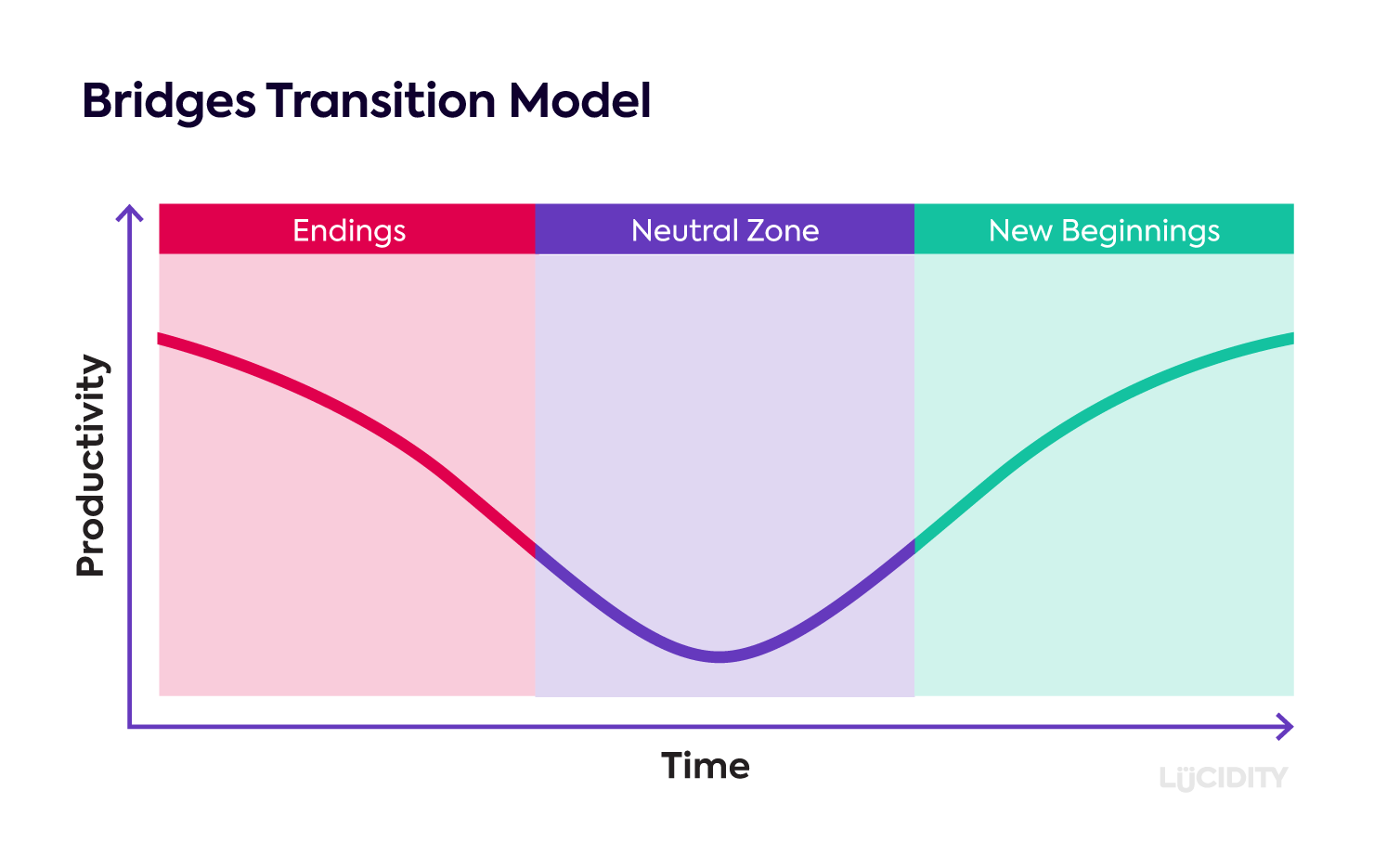Change and transition are two different concepts which are often thought of as interchangeable, so it’s probably worth us defining the two at the start of this article.
- Change is situational, it relates to a specific event or circumstance that has altered. It’s no doubt easy to think of many examples, both happy and sad, in your life.
- Transition is the personal response to change. It’s the process of adapting and accepting.
As a leader it’s important to understand the difference because your strategy with inevitably involve some level of change and some requirement of transition your team. That’s where the Bridges Transition Model can be very useful.
It’s designed to help companies manage through the process of change by focusing on the emotional side of change management. Let’s take a look in more detail…
What is the Bridges Transition Model?
The Bridges Transition Model is designed to help businesses effectively manage the change process by mapping out the human response to change over three phases.
What are are the stages of transition in the Bridges Transition Model?
There are three phases to the Bridges Transition Model:
- Endings & Letting Go
- The Neutral Zone
- New Beginnings
We’ll take a look at each now in more detail.
Endings & Letting Go
Every transition begins with an ending. It’s an important emotional stage, as if you don’t accept the ending has come and understand how to manage the loss, you won’t be able to move on and embrace the change.
This stage is the most emotionally volatile in transition. There can be many positive and negative emotions as responses.
Positive emotions may include:
- Relief
- Excitement
- Happiness
- High levels of motivation
Negative emotions may include:
- Anger
- Sadness
- Fear
- Frustration
- Uncertainty
This phase is extremely important to handle well as a leadership team, as failure to do so will have a significant impact on your overall chance of change success. Consider mapping out the different negative emotions and responses and ensure you have enough support to mitigate against each.
For example:
- Fear or uncertainty can be removed by a reassurance and clear plan communicated
- Shock or anger can be removed by involving the team early in explaining why the change is occurring
- Selling a vision of the future can result in positive emotions such as excitement appearing
The biggest take-aways from this phase are to focus on clear, supportive communication and an explanation as to why the change is needed and what the future holds.
Neutral Zone
The Neutral Zone can be the most disconcerting phase of transition. It’s time where the loss or change has occurred but the new way of working or life is not yet the status quo. Within the business context, operations may not fully be running, processes may not yet be developed, and teams may not have fully formed.
Consequently, the Neutral Zone is a phase of low productivity. Teams may be slower as they get to grips with the overheads of implementing the new change or hangovers from the old way of doing things.
Negative emotions can also start to appear and cause disruption in this phase. Team members may feel disorientated and frustrated, and a general feeling of negativity to the new way can manifest. It’s important to note that even if phase 1 was full of positivity, a poor experience in the Neutral Zone can lead to people feeling negative about the process.
Ensuring a successful transition through the Neutral Zone relies on planning and the ability to quickly respond. It should go without saying that any change needs clear planning to avoid surprises, prioritise the quicker wins to show progress, and steer the team forward. The ability to adapt and respond quickly is also needed as, even with the most detailed plan, unforeseen events will come up in execution. Be ready to positively adapt and remove barriers or blockers, as how you respond to these is as important as how well you’ve planned the approach.
New Beginnings
The last phase is where the change is complete. At this point in the transition the team and individuals are onboard with the new direction and are driving towards it.
At this point there should be positivity and energy in moving forward. Remember to celebrate getting to this phase as a team, reinforcing that the change is good. This will go towards solving your biggest challenge in this phase – sustaining the change.
What tools or frameworks complement the Bridges Transition Model?
The Bridges Transition Model is a great tool for framing the emotional journey for team members, but it is not itself a change management framework. It’s always best to use it in conjunction with other models or approaches:
- Create a Vision Statement to show direction of the future
- Consider adopting change management models like Kotter’s 8 Steps
- Use a structured strategy tool such as the Strategy Tree to help team alignment
What are the advantages of the Bridges Transition Model?
The model provides a number of advantages:
- We’re all human and that’s an important consideration in change management
- You’ll be more successful factoring in emotional response to change
- It’s a simple three stage model that’s easy to understand
What are the disadvantages of the Bridges Transition Model?
While not disadvantages, it’s important to note:
- We’re not all robots that follow the same sequence
- Emotions and people are complex and so keep that in mind when using this model
- It’s not a change management framework or substitution for one
Who invented the Bridges Transition Model?
The Bridges Transition Model was developed by William Bridges in 1991, discussed in his published book Managing Transitions: Making the Most of Change.












